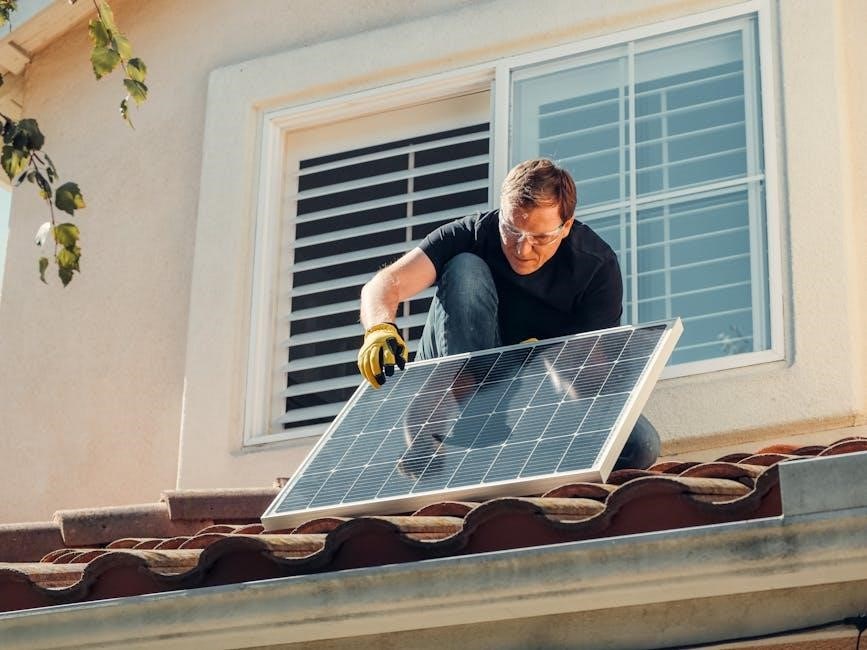
solar charge controller instruction manual
A solar charge controller is a crucial device that regulates energy flow from solar panels to batteries, ensuring safe and efficient charging. It prevents overcharging and protects against power surges, optimizing energy storage and extending battery life for enhanced system reliability.
1.1 What is a Solar Charge Controller?
A solar charge controller is a device that regulates the energy flow from solar panels to batteries, ensuring efficient and safe charging. It prevents overcharging, protects against power surges, and optimizes energy storage. Available in PWM and MPPT types, it manages voltage and current, safeguarding battery health and system performance while preventing energy waste and potential damage to connected components.
1.2 Types of Solar Charge Controllers (PWM vs. MPPT)
Solar charge controllers are primarily categorized into PWM (Pulse Width Modulation) and MPPT (Maximum Power Point Tracking) types. PWM controllers are cost-effective and suitable for small systems, using a simpler method to regulate energy flow. MPPT controllers, more advanced, optimize energy extraction by tracking the solar panel’s maximum power point, offering higher efficiency, especially in varying conditions, making them ideal for larger systems.

Safety Instructions
Always handle the controller with care, avoiding reverse connections and incorrect voltage settings. Ensure proper installation to prevent damage and ensure safe operation of your solar system.
2.1 General Safety Precautions
Before installation, read the manual thoroughly. Always wear protective gear like gloves and safety glasses. Ensure the system is grounded properly to prevent electrical shocks. Avoid touching electrical components during operation. Keep the controller away from flammable materials and ensure good ventilation. Never connect other charging sources to the controller. Always disconnect the battery before maintenance.
2.2 Electrical Safety Tips
Always ensure correct polarity when connecting cables to avoid short circuits. Use appropriately sized wires to prevent overheating. Keep the controller and connections dry to avoid electrical hazards. Regularly inspect cables and terminals for damage. Never overload the system beyond its rated capacity. Ensure the controller is properly ventilated to maintain safe operating temperatures and prevent damage from heat buildup.

Installation Steps
Connect the battery first, ensuring correct polarity, then attach solar panels and load. Follow the connection plan for cable cross-sections, and secure all terminals tightly to prevent loose connections and ensure safe, reliable operation of your solar charge controller system.
3.1 Connecting the Battery
Connect the battery to the controller by attaching the negative (-) terminal first, followed by the positive (+) terminal. Ensure correct polarity to avoid damage. Use appropriate cable sizes based on the connection plan to minimize resistance. Secure all terminals tightly to prevent loose connections, which can cause electrical issues. Always refer to the manual for specific voltage compatibility, such as 12V, 24V, or other configurations, to ensure safe and optimal charging. Proper battery connection is essential for efficient energy management and system reliability.
3.2 Connecting Solar Panels
Connect the solar panels to the controller, ensuring correct polarity and using appropriate cables as per the connection plan. The controller automatically recognizes system voltage (12V/24V or higher). Secure all connections to prevent issues. Always connect the panels after the battery to ensure safe and efficient energy transfer. Proper setup ensures optimal performance and prevents damage.
3.3 Connecting the Load
Connect the load to the controller after ensuring the battery and solar panels are properly connected. Use the correct polarity and appropriate cable size. The controller features a manual switch for load control or automatic modes like dusk-to-dawn operation. Always ensure the load’s voltage matches the system voltage. Refer to the manual for specific load control settings and compatibility with your system. Proper connection ensures safe and reliable power supply.

Understanding the LCD Display
The LCD display provides real-time monitoring of system performance, including battery voltage, charge current, and temperature. It also shows charging modes, fault indicators, and menu settings for easy navigation and control of your solar energy system.
4.1 Key Indicators and Symbols
The LCD displays essential indicators such as battery voltage, charging current, and temperature. Symbols like ✓ indicate normal operation, while ⚠ signals faults. Icons for solar input, load status, and charging modes (e.g., Bulk, Float) provide quick system insights. These visuals help users monitor performance and troubleshoot issues efficiently, ensuring optimal energy management and system reliability at all times.
4.2 Navigating the Menu
Use the UP and DOWN buttons to scroll through menu options. Press SET to enter submenus and adjust settings like charge voltage or load timing. The DOMN button toggles load output on/off. The menu includes sections for system settings, charging parameters, and load control. Navigate intuitively to customize your solar charge controller for optimal performance and energy management, ensuring all configurations meet your specific needs efficiently.
Solar charge controllers operate in multiple modes, including load control and charging modes, to optimize energy management. These modes ensure efficient battery charging and power distribution, enhancing system performance and reliability while catering to different energy needs and conditions.
5.1 Load Control Modes
Solar charge controllers feature various load control modes to manage energy distribution efficiently. These include manual and automatic switching, voltage regulation, and timing-based controls. They ensure optimal power delivery to connected devices, preventing over-discharge and extending battery life. Advanced controllers offer customizable settings, enabling users to tailor load management to their specific energy requirements and system configurations for maximum efficiency and reliability.

Operation Modes
5.2 Charging Modes (Bulk, Absorption, Equalizing, Floating)
The controller operates in four charging modes: Bulk, Absorption, Equalizing, and Floating. Bulk mode rapidly charges the battery until a set voltage is reached. Absorption mode maintains this voltage to fully charge the battery. Equalizing ensures battery health by removing sulfate deposits. Floating keeps the battery topped up, preventing overcharging and maintaining readiness for the next discharge cycle efficiently.

Troubleshooting Common Issues
Identify error codes, low voltage disconnects, and faulty connections. Check for loose wires, incorrect settings, or overloaded systems. Refer to the manual for specific solutions and FAQs to resolve issues efficiently.
6.1 Error Codes and Solutions
Common error codes like E01, E02, and E03 indicate issues such as overvoltage, undervoltage, or communication faults. Refer to the manual for specific solutions, such as resetting the controller or checking connections. Ensure all wires are secure and settings are correct. Addressing these issues promptly prevents system damage and ensures optimal performance. Always consult the troubleshooting guide for detailed resolutions;
6.2 Battery and Solar Panel Faults
Battery faults include overvoltage, undervoltage, or imbalance, while solar panel issues may involve short circuits or open circuits. Check connections for looseness or damage. Ensure panels are clean and unshaded. Use the controller’s diagnostic features to identify specific faults. Refer to the manual for corrective actions, such as resetting the system or adjusting settings to restore proper functionality and prevent further damage.

Maintenance and Care
Regularly clean the controller’s surface and vents to ensure proper airflow and prevent dust buildup. Inspect all connections and cables for damage or corrosion.
Check for firmware updates to enhance performance and security. Follow the manual’s instructions for a smooth update process to keep your system running optimally.
7.1 Cleaning and Inspection
Regularly clean the controller’s surface with a soft cloth to remove dust and debris, ensuring proper heat dissipation and visibility of the LCD display.
Inspect all terminals and connections for tightness, corrosion, or damage. Check cables for signs of wear and ensure they are securely fastened to avoid loose connections.
7.2 Firmware Updates
Regular firmware updates are essential for optimal performance and security. Check the manufacturer’s website for the latest version compatible with your controller. Download and install updates following the provided instructions. Updates may enhance features, improve efficiency, or fix bugs. Ensure the controller is connected to a stable power source during the update process to prevent interruptions.

Warranty and Support
Most solar charge controllers come with a 12-36 month warranty. Contact customer support for assistance with repairs or replacements. Ensure proper installation to maintain warranty validity.
8.1 Warranty Information
The solar charge controller typically comes with a 12-36 month warranty, covering manufacturing defects. Proper installation and adherence to guidelines are essential for warranty validity. Repairs, replacements, and technical support are provided during this period. Ensure compliance with product specifications to maintain coverage and resolve issues promptly.
8.2 Contacting Customer Support
For assistance, contact customer support via email, phone, or through the official website. Visit the manufacturer’s site for support contact details. Have your product serial number ready for efficient service. Support teams are available to address technical queries, provide troubleshooting guidance, and assist with warranty claims. Ensure to reference your product manual for specific support contact information;
Technical Specifications
Technical specifications include voltage and current ratings, ensuring compatibility with various solar systems. The controller supports 12V/24V auto-recognition and handles maximum current ratings up to 40A efficiently.
9.1 Voltage and Current Ratings
The controller supports system voltages of 12V/24V or extended configurations up to 48V, with automatic recognition for versatility. Maximum current ratings vary by model, up to 40A, ensuring compatibility with diverse solar panel setups and battery systems for efficient energy management and safe operation across various applications.
9.2 Compatibility with Battery Types (Lead-Acid, Lithium)
The controller supports both lead-acid and lithium batteries, offering flexible energy storage solutions. It features a switch or interface to select battery type, ensuring optimal charging algorithms for each chemistry. Automatic voltage recognition (12V/24V) enhances compatibility, while advanced settings allow customization for specific battery needs, ensuring efficient and safe charging across various setups and applications.

Advanced Features
Advanced features include MPPT tracking efficiency, remote monitoring options, and smart charging algorithms. These enhance energy harvesting, system monitoring, and adaptability to different battery types and conditions.
10.1 MPPT Tracking Efficiency
MPPT (Maximum Power Point Tracking) ensures optimal energy extraction from solar panels by continuously adjusting the charge controller to match the panel’s maximum power point. This advanced algorithm maximizes energy harvesting, especially under varying light conditions, and minimizes power loss, resulting in higher overall system efficiency and faster battery charging times compared to traditional PWM controllers.
10.2 Remote Monitoring Options
Advanced solar charge controllers offer remote monitoring through Wi-Fi or Bluetooth, enabling real-time tracking of system performance via smartphones or computers. Users can monitor voltage, current, and battery status, receive alerts, and adjust settings remotely. This feature enhances convenience and ensures optimal system performance without physical access to the controller, making it ideal for off-grid installations.
Parameters and Settings
Configure charge voltage and current settings to optimize battery charging. Adjust parameters to prevent overcharging and ensure efficient energy storage, following the manual’s guidance for precise setup.
11.1 Setting Charge Voltage and Current
Adjust the charge voltage and current to match your battery type and capacity. For lead-acid batteries, set the voltage between 14-15V for bulk charging. Lithium batteries require lower settings, typically 12-14V. Use the LCD menu to configure these parameters, ensuring they align with manufacturer recommendations to optimize charging efficiency and battery longevity. This prevents overcharging and extends lifespan.
11.2 Configuring Load Control Settings
Configure load control settings to manage energy distribution efficiently. Use the LCD menu to enable modes like automatic dusk-to-dawn operation or continuous 24-hour output. Set timers or adjust sensitivity to customize load behavior. Ensure settings align with your system’s requirements to optimize energy use and protect the battery from excessive discharge.
A solar charge controller is essential for efficient energy management. Proper use ensures optimal charging, system protection, and extended battery life, maximizing your solar setup’s performance and longevity.
12.1 Summary of Key Features
Solar charge controllers regulate energy flow from panels to batteries, preventing overcharging and ensuring efficient storage. They support PWM and MPPT technologies, offering high efficiency and compatibility with various battery types. Advanced models feature LCD displays, multiple load control modes, and automatic voltage recognition. They also include temperature compensation, short-circuit protection, and remote monitoring options, ensuring safe and optimal performance. These devices are built for durability and reliability, providing a robust solution for solar energy management while being environmentally friendly and cost-effective.
12.2 Final Tips for Optimal Use
Regularly inspect connections to ensure they are tight and corrosion-free. Clean the solar panels periodically to maximize energy absorption. Monitor system performance using the LCD display or remote monitoring options. Adjust settings seasonally to optimize charging efficiency. Store the controller in a cool, dry place during extended periods of non-use. Always follow the manufacturer’s maintenance schedule for longevity. Stay informed about firmware updates and best practices for your specific model to ensure optimal performance and safety.